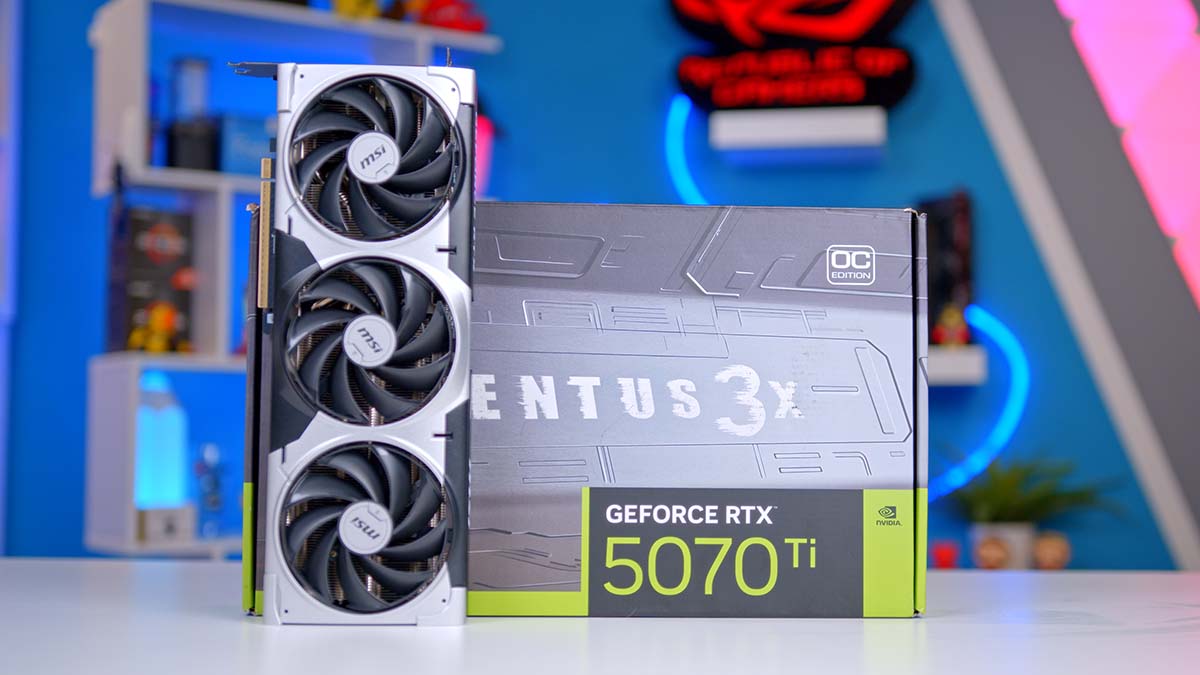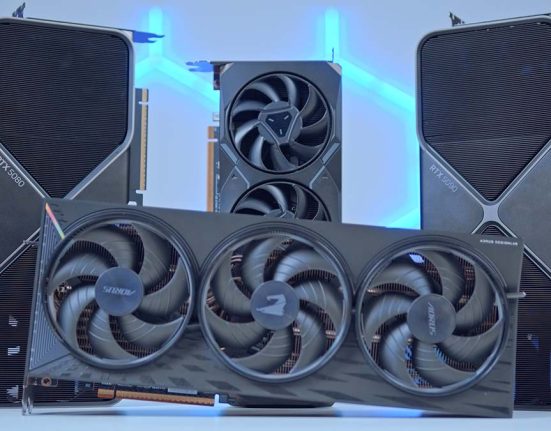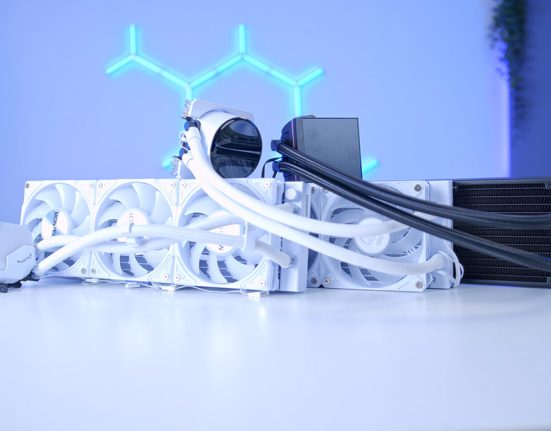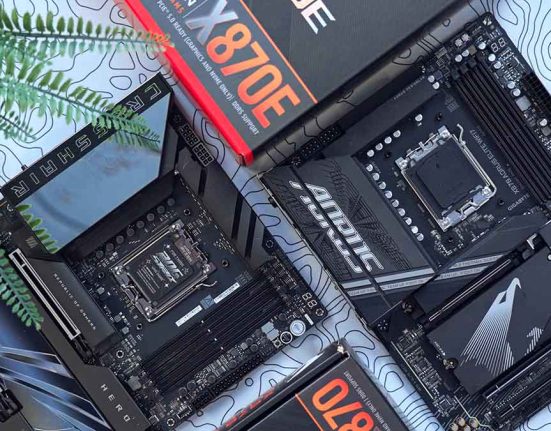The MSI RTX 5070 Ti Ventus 3X is one of the few RTX 5070 Ti models available for MSRP. Like the RTX 4070 Ti launch and SUPER variant, NVIDIA has decided not to offer a Founders Edition model for the RTX 5070 Ti, leaving it up to AIB manufacturers to provide an affordable option amongst the non-MSRP variants. This is where the MSI Ventus 3X comes in. As an MSRP entrant, the Ventus 3X immediately offers a more enticing proposition than other RTX 5070 Ti graphics cards, but one big question remains. How does it perform? Like our other 50-series content, the MSI Ventus 3X variant has been rigorously tested and benchmarked.
The 70-Ti class of GPUs is in an awkward position compared to NVIDIA’s other RTX 5000 cards. The main reason is the price. NVIDIA notes that the MSRP (manufacturer suggested retail price) of the RTX 5070 Ti is $749, but based on the stocking and pricing of the RTX 5080, it’s difficult to know whether it’ll be easy to pick up an RTX 5070 Ti at this all-important MSRP. I don’t think $749 is unreasonable, especially for those who value 4K performance more. Still, it’s not a great look for NVIDIA to offer a reasonable MSRP and then have no consumers be able to pick up this card at this price.
But despite this, our sentiment around the RTX 5070 Ti isn’t all bad. The Blackwell architecture significantly boosts performance compared to Lovelace, which we’ll touch upon later in the benchmarking section. Additionally, the benefits of DLSS and Frame Gen continue to impress us in supported games, especially when Ray Tracing is enabled, which can tank performance.
We’ll be reviewing the RTX 5070 Ti today in a full-fledged review of the MSI Ventus 3X variant. This article explores the specs, architecture, design, and performance, allowing us to give an overview of the card and determine whether it’s a worthwhile purchase.
Specification
As mentioned above, the RTX 5070 Ti has launched at $749.99, which is $50 less than the RTX 4070 Ti SUPER, which hit the market at $799.99. While the price drop is appreciated with the new generation, as we’ve alluded to, it will still be a hard sell based on its overall market positioning and performance. However, we’ll leave the performance metrics for later on. Regarding the specs, the most significant upgrade compared to the previous generation cards is the switch to GDDR7, which means RTX 5000 cards can use the PCI-E 5.0 slots that have saturated the market over the past few years.

It would have been nice to see the RTX 5070 Ti get more VRAM, especially compared to the RX 7900 XT, which has 20GB of graphical memory. However, 16GB will suffice for most games. On paper, the RTX 5070 Ti is similar to its RTX 4000 counterpart, with minor uplifts to the CUDA, RT and Tensor Cores. Power consumption has also increased from 285W to 300W, which means some prospective buyers could be looking at a power supply upgrade.
| Key Specs | RTX 5080 | RTX 5070 Ti | RTX 4070 Ti SUPER |
|---|---|---|---|
| Video Memory | 16GB GDDR7 | 16GB GDDR7 | 16GB GDDR6X |
| Memory Bus | 256-bit | 256-bit | 256-bit |
| Base Clock Speed | 2.29GHz | 2.3GHz | 2.34GHz |
| Boost Clock Speed | 2.61GHz | 2.45GHz | 2.61GHz |
| CUDA Cores | 10752 | 8960 | 8448 |
| RT Cores | 88 | 70 | 66 |
| Tensor Cores | 336 | 280 | 264 |
| Power Consumption | 360W | 300W | 285W |
| MSRP | $999.99 | $749.99 | $799.99 |
As we’ve mentioned in our other 50-series content, another big change is the uplift to AI TOPS performance, which NVIDIA says is required for the latest generation of DLSS, DLSS 4. DLSS is one of the pillar technologies of NVIDIA RTX graphics cards, and its advancements over the years have brought considerable upgrades to graphical performance in modern games, making it a worthwhile setting to turn on when available. The latest technology added to DLSS, known as Multi Frame Generation, continues to uplift performance, making games much smoother even at high settings.
Design
Moving onto the design, the Ventus 3X model of the RTX 5070 Ti is a fairly barebones GPU. As an MSRP card, it’s no surprise that MSI has made a few sacrifices to the look to save on costs. The resultant effect is that the MSI Ventus 3X RTX 5070 Ti is pretty simple. This is a triple-fan model with a light grey and black shroud. The front of the card features a light grey colour, which is somewhat different from older Ventus models, which are predominantly black.

At the back of the card, you’ll find the black metal backplate, which provides rigidity and stability for the GPU. Aesthetically, the RTX 5070 Ti Ventus 3X is relatively basic. The card has no RGB, and the colour scheme is ultimately quite plain. I would have preferred if this card was entirely black instead of this odd mix of grey and black, as this would make it blend in easier with darker builds, but some builders will appreciate the look.

In terms of cooling support, as the Ventus 3X variant is a triple-fan model, gamers can expect solid temperatures during gaming. This card doesn’t employ a vapour chamber or fancy techniques to keep things cool. However, the three TORX fans offer ample airflow, ensuring the card stays cool during varying workloads.
Architecture
Launching alongside the RTX 5000 cards is a new generation of DLSS, version 4.0. This is a generation-specific technology, meaning only RTX 5000 graphics cards will be able to utilise DLSS 4 to its full extent. This comes down to the AI TOPS we mentioned earlier. The enhanced AI performance powers DLSS 4.0 and Multi Frame Generation and is, therefore, too much for older graphics cards.
Breaking down DLSS and Multi Frame Generation into Layman’s terms, DLSS is an AI-based upscaler using years of machine learning to track and upscale frames accurately in a video game. This means you can run your game at 1080p and leverage the performance benefits of a low resolution but have DLSS upscale to 1440p, allowing you to enjoy better visual fidelity with few caveats.

Over the years, DLSS has constantly been refined to improve latency and performance overhead, minimising the impact on your PC while running. Multi Frame Generation, conversely, is a technology that makes your game run smoother by rendering additional frames. It takes data from a rasterised frame and renders three additional frames alongside it, making your game look and feel buttery and smooth. Across our testing, we found that frame rates were nearly double those of rasterised gameplay, which can be beneficial in titles that feel choppy or don’t look the best.
Unfortunately, Multi Frame Generation isn’t without its drawbacks. The most significant caveat to be aware of is latency. Turning on Multi Frame Generation can increase system latency by quite some margin, but the results aren’t the same in every game. For example, in Hogwarts Legacy, we only saw latency increase by 2ms, whereas in Cyberpunk 2077, our latency result was 16ms, which is going to be pretty noticeable. If you’re a gamer who plays a lot of FPS titles that require fast responsiveness, we don’t recommend switching this on until latency improves.
Performance
As always, all of our benchmarking and testing is done by our in-house benchmarker, Harry Coleman, who has worked tirelessly to gather all the data needed for our RTX 5000 series content. The RTX 5070 Ti and a range of competitor graphics cards have been tested in our primary benchmarking system paired up with the AMD Ryzen 7 9800X3D to provide the best framerates possible across all of the titles we tested. The games featured in this benchmarking section provide a mix of AAA games and modern Esports titles to see how the RTX 5070 Ti holds up in a range of games.
Cyberpunk 2077
Settings: 4K, Shadow Quality High, Indirect Lighting High, Reflections High, Crowd Density High, Particle Quality High, Volumetric Lighting High, Motion Blur off, GTAO Quality High, Grass Quality High, Contact Shadows High VSync Off, DLSS: On/Off, Ray Tracing: On/Off, Textures: High
Starting with Cyberpunk 2077 at 4K high, rasterisation only, the RTX 5070 Ti offered a good baseline result in this benchmark with an 80FPS average, compared to the RTX 5070 Ti, which sits at 62FPS. This is a significant jump at 4K, which may put the 5070 Ti in a better market position, targeted as a 4K card if the rest of our benchmarks follow suit.
It’s also worth noting that the RTX 5070 Ti beat out the previous generation’s RX 7900 XTX in this run, which is a 24GB graphics card. This clearly shows that VRAM isn’t everything at high resolutions.

After we switched on DLSS, Frame Gen and ray tracing, the RTX 5070 Ti offered a noticeable improvement up to 93FPS, which is nearly 15FPS more compared to the rasterised benchmark. Ray tracing is obviously impacting framerates here, which is why Frame Gen has been added on top to supplement framerates. The RTX 4070 Ti SUPER in this run didn’t sit particularly far behind, offering a very reasonable 83FPS, just 10FPS less than the RTX 5070 Ti. It may be worth holding onto your RTX 4070 Ti SUPER if you plan on playing intense games.

Alan Wake II
Settings: 4K, Post-Processing High, Texture Resolution High, Texture Filtering High, Volumetric Lighting High, Global Illumination Quality High, Shadow Detail High, Terrain Quality High, Ray-Tracing: Enabled, Ray Tracing Preset High, DLSS: On/Off, Frame Generation: On/Off
In Alan Wake 2 at 4K with rasterised gameplay, the RTX 5070 Ti struggled, outputting an average FPS of 51. Unfortunately, this game isn’t optimised for pure rasterised gameplay, so even cards like the RTX 5090 couldn’t cope entirely. If we look at the RTX 4070 Ti SUPER results, framerates are even worse, with this previous generation card sitting at 45FPS.

With DLSS, ray tracing and frame generation enabled, the overall performance isn’t much better. While visual fidelity has significantly increased, Alan Wake 2 is again proving to be one of the most complex titles to run at 4K, costing gamers plenty of frames. It’s worth considering dumbing down the settings in this title to enjoy higher frames.

Hogwarts Legacy
Settings: 4K Effects High, Material High, Fog High, Sky High, Foliage High, Post Process High, Shadows High, Textures High, View Distance High, Population High, Anti Aliasing TAA High, Windowed Fullscreen
In Hogwarts Legacy at 4K, the RTX 5070 Ti offered a decent 88FPS, versus the RTX 4070 Ti SUPER, which hovered around 72FPS. Across the board, we’re seeing a decent uplift in performance at 4K, which is great despite how similar these cards are on paper. In this benchmark, the RTX 5070 Ti gets beaten out by the RX 7900 XTX which isn’t a huge surprise considering how much VRAM it has.

Once we switched on DLSS, framerates increased across all the cards we tested. The RTX 5070 Ti sits in between the RX 7900 XTX and RTX 4080 with an average framerate of 122FPS. This is considerably stronger than the rasterised gameplay, with DLSS providing a 40FPS bump at 4K. Unfortunately, the RTX 4070 Ti SUPER isn’t quite able to catch up, hovering around 107FPS in this title.

Marvel Rivals
Settings: 4K, Graphics Quality High, Global Illumination Lumen GI- High Quality, Reflection Quality Screen Space Reflections, Model Detail High, Post-Processing High, Shadow Detail High, DLSS On/Off, Frame Gen On/Off
Dropping the resolution to 1440p in the hit Esports title Marvel Rivals, the RTX 5070 Ti reached 140FPS in this benchmarking run, which is pretty impressive despite being a rasterised benchmark. The RTX 4070 Ti SUPER offered somewhat similar performance with a 128FPS average. High framerates are essential in this title, so the RTX 5070 Ti is the more favourable of the two, especially for those with high refresh rate displays.

After we switched on DLSS and Frame Gen, the RTX 5070 Ti’s performance skyrocketed, with this card sitting at a healthy 257FPS. However, the RTX 4070 Ti SUPER is pretty close, offering 234 frames on average. Ultimately, at framerates this high, the performance difference isn’t going to be particularly visible. However, it’s great that the RTX 5070 Ti still offers a decent improvement over the RTX 4070 Ti SUPER at 1440p.

COD Black Ops 6
Settings: 4K, Graphics Preset Custom, Texture Resolution High, Depth of Field On, Detail Quality High, Particle Resolution High, Shader Quality High, Shadow Quality High, Screen Space Shadows High, DLSS On/Off, Frame Gen On/Off
In COD Black Ops 6 Zombies at 1440p high, the RTX 5070 Ti outputs a solid average framerate of 147FPS, followed by the RTX 4070 Ti SUPER sitting at 141FPS. This game is relatively well-optimised, so there isn’t a massive gap between each card we’ve tested. Unfortunately, DLSS doesn’t do much to improve the standings either, so it will be better to play this title natively to avoid latency or visual fidelity loss.

Apex Legends
Settings: 1440p, Anti-aliasing TSAA, Texture Filtering 8X, Model Detail High, VSync Disabled, Effects High, Ambient Occlusion Quality High
Our penultimate benchmarking run was Apex Legends, maintaining the resolution of 1440p. Unsurprisingly, the RTX 5070 Ti in this title maxed out the framerate. Despite unlocking the FPS, Apex Legends has a cap of 300FPS, and the RTX 5070 Ti sits at 298FPS, so there’s not much more to be gained here. The RTX 4070 Ti SUPER weirdly does lose out by about 10FPS in this benchmark, but again, at framerates this high it doesn’t hugely matter.

Fortnite
Settings: 1080p, Competitive, View Distance Far, FPS Unlimited, VSync Off, Anti-Aliasing TAA, Shadows Off, Reflections Off, Textures Low
Last but not least is the hit battle royale Fortnite, where we dialled the resolution down to 1080p, and the settings to low. This benchmark isn’t really used to test performance, but it gives us an idea of where each generation lands. The RTX 5070 Ti in this particular benchmark offered up 405FPS, which is oddly weaker than the RTX 4070 Ti SUPER at 433FPS. This could be down to drivers or other factors, but we’re not worried that the RTX 5070 Ti is going to struggle purely based on how ridiculous the results are at 1080p.

Conclusion
MSI RTX 5070 Ti Ventus 3X
Product Name: RTX 5070 Ti Ventus 3X
Brand: MSI
-
Features
-
Design
-
Performance
-
Value For Money
Summary
After evaluating the specs, design, architecture, and, more importantly, performance, where does the RTX 5070 Ti stand compared to the current and previous generation options? Unfortunately, the answer is a bit of a mixed bag. Undoubtedly, the RTX 5070 Ti is a better buy than the previous generation offering. It’s cheaper (by about $50), offers a nice performance boost at 4K, with a slightly disappointing upgrade to 1440p performance, and you get to leverage the benefits of DLSS 4, which, as we’ve said in our other 5000 series content, is exceptional. NVIDIA continues to prove that its advancements in the AI space are not without merit, as DLSS outshines the competition significantly.
However, the big caveat is pricing. The $749 MSRP of the RTX 5070 Ti is more or less where we expected this card to land during its announcement, but offering only one or two cards available at MSRP was a bad decision. As we’ve seen with the RTX 5080, stocking isn’t great, and the vast majority of RTX 5000-series cards are priced way above what they should be, and this is likely to happen with the RTX 5070 Ti. We could be wrong, but it won’t surprise me if the few MSRP cards immediately sell out, leaving the $200-$300 more expensive variants sitting on the shelves. This card is costly, but it could be a competitive offering targeted at builders looking for an entry-level 4K option if NVIDIA and AIB manufacturers offered a more substantial selection of cards available at that all-important MSRP price point.
Pros
✅ Solid 4K performance
✅ MSI Ventus is MSRP
✅ Multi Frame Gen is great
Cons
❌ Few MSRP cards
❌ Small upgrade to 1440p performance
❌ Expensive








